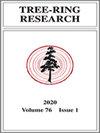1333 - 2015年美国华盛顿州北喀斯喀特山脉西坡黄杉的树木气候学与温度变化
IF 1.1
4区 农林科学
Q3 FORESTRY
引用次数: 1
摘要
长期古气候温度重建提供了近期人为变暖幅度的背景,有助于量化气候对辐射强迫的响应,并更好地表征自然变率的范围。在北美,温度敏感的树木年轮代理数据仍然稀少,这限制了这些重建的时空范围。本文分析了美国华盛顿州黄杉(Callitropsis nootkatensis)的生长及其与气候的关系。结合实证统计分析和木质发生过程模型,我们发现北Cascades三个高海拔地区的树木年轮年表主要受温度控制。然后,我们使用这些年表来重建公元1333年至2015年期间的夏季温度,并为北美温度敏感树木网络添加了一个新的代理。与现有的大规模空间网格重建的比较表明,该物种提供了有关过去温度的重要本地和区域信息。本文章由计算机程序翻译,如有差异,请以英文原文为准。
Dendroclimatology of Yellow-Cedar (Callitropsis nootkatensis) and Temperature Variability on the Western Slopes of the North Cascades in Washington State, USA, from 1333 to 2015 CE
ABSTRACT Long-term paleoclimate reconstructions of temperature provide context for the magnitude of recent anthropogenic warming, help quantify the climate response to radiative forcing, and better characterize the range of natural variability. In North America, temperature-sensitive tree-ring proxy data remain sparse, which limits the spatial and temporal extent of these reconstructions. Here we present an analysis of yellow-cedar (Callitropsis nootkatensis) growth in Washington State (USA) and its relationship to climate. Combining empirical statistical analysis with a process model of xylogenesis, we show that tree-ring chronologies from three high-elevation sites in the North Cascades are primarily controlled by temperature. We then use these chronologies to reconstruct summer temperatures over the period 1333 to 2015 CE, adding a new proxy to the North American network of temperature-sensitive trees. Comparison with an existing large-scale spatial gridded reconstruction suggests this species offers important local and regional information on past temperatures.
求助全文
通过发布文献求助,成功后即可免费获取论文全文。
去求助
来源期刊

Tree-Ring Research
农林科学-林学
CiteScore
2.40
自引率
12.50%
发文量
15
审稿时长
>36 weeks
期刊介绍:
Tree-Ring Research (TRR) is devoted to papers dealing with the growth rings of trees and the applications of tree-ring research in a wide variety of fields, including but not limited to archaeology, geology, ecology, hydrology, climatology, forestry, and botany. Papers involving research results, new techniques of data acquisition or analysis, and regional or subject-oriented reviews or syntheses are considered for publication.
Scientific papers usually fall into two main categories. Articles should not exceed 5000 words, or approximately 20 double-spaced typewritten pages, including tables, references, and an abstract of 200 words or fewer. All manuscripts submitted as Articles are reviewed by at least two referees. Research Reports, which are usually reviewed by at least one outside referee, should not exceed 1500 words or include more than two figures. Research Reports address technical developments, describe well-documented but preliminary research results, or present findings for which the Article format is not appropriate. Book or monograph Reviews of 500 words or less are also considered. Other categories of papers are occasionally published. All papers are published only in English. Abstracts of the Articles or Reports may be printed in other languages if supplied by the author(s) with English translations.
 求助内容:
求助内容: 应助结果提醒方式:
应助结果提醒方式:


